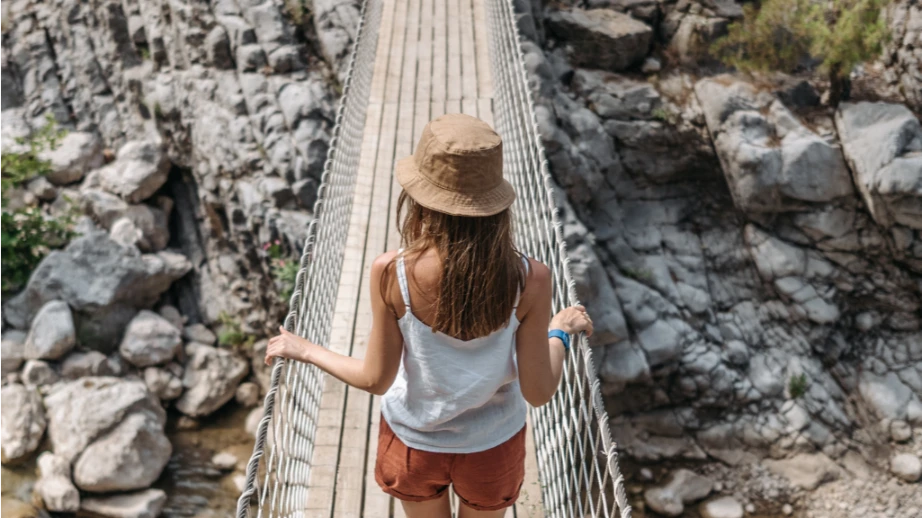Wading through the sea of hats options at REI or Backcountry is overwhelming. With so many styles, materials, features, and mixed reviews, how do you pick the right one?
After testing more than 10 different hats in the last year alone, I’ve compiled a list of features that you should look for when buying a hat for hiking.
Choosing a hiking hat isn’t as straightforward as you might think. It’s not just about picking the first one off the shelf that catches your eye. You need a hat that will stand up to the elements and still keep you comfortable.
In this guide, I’ll walk you through everything you need to know to make an informed decision.
What to Look for in Hiking Hats? The Most Important Features
Here, I’ll point out 9 features you should look for. While it’s nearly impossible to find a hat that ticks off every single box, try to find a hiking hat that has the most important features: It’s lightweight and breathable, offers unbeatable sun protection and can last for years to come.
Lightweight and Breathable Options
Temperatures soaring up to 95°F (35°C) are not uncommon, and in such conditions, you need a hat made of lightweight, breathable materials such as nylon or polyester. These fabrics are engineered to be ultra-light and don’t bog you down during your hike.
But it’s not just about the weight. Look for hats with mesh panels or ventilation holes that promote airflow and keep your head cool. This is especially important if you tend to sweat a lot during hikes.
Sun Protection
A hat with UPF 50+ can block out about 98% of the UV rays from reaching your skin. In areas with a UV index of 11+, which isn’t uncommon in places like the Mojave Desert or the Rockies during summer, the sun doesn’t just tan. It can burn and damage in less than 15 minutes.
When you’re on the hunt for that perfect hiking hat, here are a few pointers to keep in mind:
- UPF Rating: Look for UPF 50+. It’s the gold standard in sun protection.
- Brim Width: A wider brim (at least 2.5 inches) offers more coverage, not just for your face but also for your neck and ears.
- Material: Lightweight, breathable fabrics with a tight weave offer better UV protection without making you overheat.
- Color: Ever wonder why desert dwellers prefer light-colored clothing? Light shades reflect the sun’s rays better than dark ones, keeping you cooler.
Don’t skimp on sun protection. A good hat might cost a bit more ($40+), but it’s a small price to pay for the health of your skin. Remember, long-term exposure to UV rays increases the risk of skin cancer.
Durability and Shape Retention
You’ve got this fantastic hiking hat. It fits perfectly, shields you from the elements, and then one day, it just gives up. Maybe it gets crushed under your gear, or it starts to fray after a few washes.
Look for the most durable hats possible so you can keep exploring without worrying about constantly replacing your headgear. I strongly recommend hats made by Sunday Afternoons.
What makes these hats stand out is their incredible durability. My Sunday Afternoons Adventure Hat has been with me for over five years and it’s still going strong.
I also love their shape retention. You can stuff them into your backpack, sit on them accidentally, or leave them crumpled in the corner of your tent, and they bounce back, ready for action.
Other Important Features to Look for

Adjustable Fit
The best hiking hats should stay in place when faced with wind speeds of 20-25 mph. An adjustable fit secures your hat in these challenging conditions, provides comfort over long periods and adapts to different head sizes (yes, our heads swell a bit after hours of hiking).
So, how do you ensure your hat stays put without compromising on comfort?
- Look for a Drawstring or Chin Strap: A hat with a drawstring or chin strap can be easily adjusted to snugly fit your head. Don’t worry about discomfort – modern designs ensure that these features feel like they’re barely there.
- Elastic Bands: Some hats come with an internal elastic band that offers a flexible fit. Your hat can adapt to slight changes in your head size throughout the day.
- Velcro Straps: They offer a level of adjustability that’s hard to beat. You can quickly tighten or loosen your hat based on the wind’s intensity, all without breaking stride.
A hat flying off not only interrupts your hike but can also pose a risk of losing it in inaccessible areas. Even worse, constantly worrying about your hat takes away from the experience of being one with nature.
Moisture Management
When you’re hiking, especially in areas where humidity reaches 80% and more, managing sweat becomes more than just a comfort issue – it’s about staying focused and keeping the sweat out of your eyes and off your face.
That’s why your new hiking hat should have moisture-wicking fabric. My advice is to look for labels. If it says “moisture-wicking” on the tag, you’re off to a good start. Brands such as Sunday Afternoons, REI or Cotopaxi know the importance of this feature and will make sure you know their hats have it.
The next thing you should care about is the fabric itself. We’ve already discussed the importance of polyester and nylon in keeping your hat lightweight and breathable. Well, these materials also excel at moisture management. They’re engineered to move moisture away from your skin and dry quickly.
And here’s the old good hiking advice: avoid cotton. While it feels soft and comfortable, it’s a trap when it comes to moisture management.
Visibility After Dark
While we often equip ourselves with headlamps, flashlights, and maybe even wear clothes with reflective patches, how many of us think about the visibility features of our hats? Not many, I’d bet. But, it’s still a nice-to-have feature, especially when visibility drops to less than 500 feet (150 meters).
Whether it’s a reflective logo, piping, or stitching, these features can catch the light from a distance, making you visible to fellow hikers, bikers, or even vehicles if you’re near roads.
Insect Repellent Technology
Did you know that in some areas, the mosquito density can exceed 1,000 per square yard? It’s a buzzing, biting nightmare waiting to happen. This is where hats with built-in insect repellent technology can save the day
These hats are treated with substances that bugs find repulsive. The most common one you might have heard of is permethrin. It’s a synthetic chemical that mimics natural extracts from the chrysanthemum flower, and bugs absolutely hate it.
The best part? You won’t even notice it’s there. There’s no smell or residue, but the bugs sure can tell, and they’ll steer clear.
Before investing in a hat with this technology, check how long the treatment lasts. Some hats offer protection for several washes before needing a re-treatment.
It’s hard to find hats like this but I’m currently testing this one from Amazon and it works well for now.
Packability for Backpackers
When you’re gearing up for a multi-day trek, you’re probably aiming to fit your life into a 50L to 70L pack. That doesn’t leave a lot of room for “just in case” items. Every single thing you decide to bring along needs to earn its keep, including your hat.
You need one that can squish down into the nooks and crannies of your pack without looking like it just survived a natural disaster when you pull it out.
Again, my winner in this category is the Sunday Afternoons Adventure Hat. It is packable and bounces back to its original shape, no matter how carelessly I stuffed it into my pack.
Removable Sweatbands
What makes removable sweatbands so special? Simply put, they’re washable. After a long day of traversing valleys, you can easily take the sweatband out of your hat, give it a good wash, and it’s like you’ve got a brand-new hat ready for tomorrow’s hikes.
This goes beyond maintaining a fresh scent. It’s also about ensuring your skin stays clear and happy. Sweat buildup can lead to skin irritation or even breakouts, and we don’t want that.
Washing your sweatband regularly means it needs to hold up well. Read reviews to ensure that the sweatband won’t fall apart after a few washes.
Alternative Sun Protection Strategies
Not everyone is a hat person, and that’s perfectly okay. Maybe it squashes your hairstyle, or perhaps it just doesn’t vibe with your look. The goal here is to stay protected from the sun’s rays, so let’s explore two top-notch alternatives that keep you cool and shielded without compromising on style or comfort.
Sun Protective Hoodies
Designed with fabrics that boast a high UPF (Ultraviolet Protection Factor) rating, sun hoodies are engineered to block out a significant portion of UV rays.
What makes them stand out, especially for those of us who find hats a bit cumbersome, is their simplicity. Slip one on, and you’ve got coverage for your arms, torso, and head.
Lightweight options won’t weigh you down during sweltering summer hikes, while the thicker, cozier versions are perfect for when the temperature dips but the sun still insists on joining your journey.
Buff Headwear: A Year-Round Option
Buff headwear is a piece of fabric offering unparalleled versatility that adapts to your needs, no matter the season.
Weighing in at a mere 1-1.5 ounces for the summer variants, buffs are virtually weightless companions that provide excellent protection against the sun. For chillier hikes, winter buffs come to the rescue, insulating you from temperatures as low as 30°F (-1°C).
What makes buff headwear a year-round champion is not just its ability to protect you from the sun but also its adaptability. Wear it as a neck gaiter, pull it up as a face mask, fashion it into a headband, or even wear it as a makeshift hat. The possibilities are endless, and the protection is steadfast.
With an array of designs and patterns available, buffs effortlessly complement any hiker’s style, making them a go-to for those who prioritize functionality without sacrificing fashion.
Conclusion
By now, you’ve probably realized that while there’s a whole world of features out there, it all boils down to four key pillars: light weight, breathability, sun protection, and durability. These aren’t just nice-to-haves. They’re your non-negotiables.
When you’re standing there, facing a sea of options, remember these pillars and you’ll find the perfect hike-ready hat in no time.

Lukas Heller
Hey there! I’m Lukas, co-founder of BigfootHiking.com, alongside my adventurous wife Martha. Originally from Germany, I landed in Phoenix, Arizona, in 2015, where I’ve been scouting out new trails ever since (though they’re getting scarce!). By day, I’m a software developer, but my heart belongs to hiking – I’m always plotting our next trip. When I’m not coding or on the trails, you’ll find me hanging out with our Pit Bull, Zeus.




